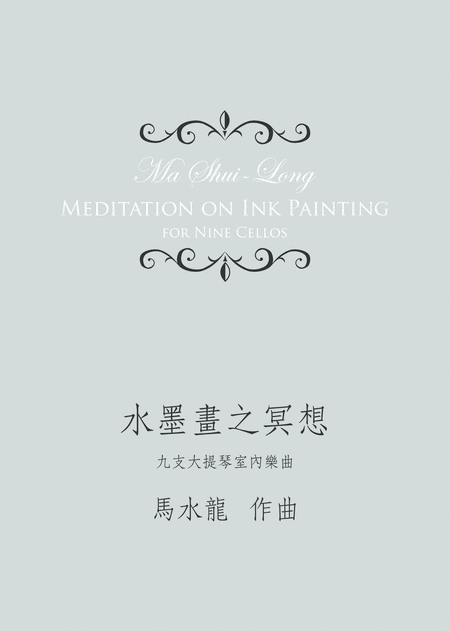Cello Solo - Digital Download SKU: A0.961997 Composed by Ma Shui Long 馬水é¾. 20th Century,Contemporary. Individual part. 17 pages. SpringAutumnmusic #2341883. Published by SpringAutumnmusic (A0.961997). ã水墨ç«ä¹å¥æ³ãï¼ä¹æ¯å¤§æç´å®¤å
§æ¨æ²ï¼ 1994å¹´ ä½æ²è
èªå¹¼åæ繪ç«èé³æ¨ãç¾å¾ï¼éç¶é¸æäºé³æ¨çºçµèº«å¿æ¥ï¼ä½å°ç¹ªç«çè趣èçç±ï¼å§çµæå¢ç¡æ¸ãå¨å·²å®æçé³æ¨ä½åä¸ï¼å¹¾é¦åè繪ç«æå¯åçéä¿ãä½æ²è
èªçºï¼ææçèè¡åµä½ï¼éç¶å å
¶ä½¿ç¨çç´ æä¸åæ表ç¾çææ³ç¸ç°ï¼ä½æå¾æè¦åç¾çèè¡æ¬è³ªï¼ææ¯æ®éåæ¸ï¼é³æ¨è繪ç«æ´æ¯ä¸ä¾å¤ã æ¬æ²åµä½çåæ©ï¼ä¾èªæ¼å³çµ±æ°´å¢¨ç«ä¸çãè實ç¸çãè§å¿µãå¤äººç¬ªéå
ãç«çãäºï¼å¯¦èä¹å¦ï¼çå èèèçï¼ä¹å°±æ¯ç¡èä¸æ顯實ï¼ç¡ç©ºä¸è½åèãç¡çä¸è½æå¯ï¼ç¡å¯ä¸è½è¦çï¼æ¯ä»¥è實ç¸çï¼çå¯ç¸ç¨ãä½æ²è
試å以æ¤ç¹ªç«ææ³ï¼åç¾å¨æ¤é¦æ¨æ²çµæ§ä¸ï¼å¦æéè空éçå°æ¯ï¼ç¹åº¦èå¯åº¦çäºæï¼å¯¦é«è空éçè½è®çï¼ä»¥æ±é³ç«ä¹æå¢ã â»æ¬æ²ç±æ建æå§è¨åµä½ï¼é¦æ¼æ¼1995å¹´11æ25æ¥æ¼å家æ¼å¥å»³ï¼ç±è²¡åæ³äººé±åèææåºéæ主辦ä¹ãæ¥ç§æ¨é95ç§ Â· 室å
§æ¨ä¹å¤ããç±æ¶æ æ°æä»»ææ®ï¼å¤§æç´æ¼å¥å®¶çºå«ç¬ç²ãé»æºçãé佩ç²ãæ¾å²å¦ãæ´ªå©å®¹ãé»é»å®ãåå§å«¥ãèåè³ãç佩çã ãMeditation on Ink Paintingãfor Nine Cellos ï¼1994ï¼ Music and painting are two beloved arts for Professor Ma since he was a kid. Even he finally decided devoted to music composing for his life, he always had the passion for painting. Several Professor Maâs compositions were highly inspired from the concepts and techniques of painting. Professor Ma believed that all the arts, although they present differently on the usages of materials or techniques, the essence and highest acheivement of all arts must be the same, including both music and painting. Meditation on Paintings in Ink was directly inspired by the techniques of Chinese traditional ink painting and the concept of the mutuality in virtuality and reality. The composer attempted to transform the philosophy that derive from the virtuality-reality relationship into the composition, presented it as the contrast between time and space, the alternation of texture and density, or, the changing of emptiness and fullness, etc., in order to establish an artistic atmosphere of musical painting. Meditation on Paintings in Ink was commissioned by the Council for Cultural Affairs, premiered in the National Concert Hall, on 25th of November 1995. It was programed in the Euterpe: Spring and Autumn concert series Autumn 1995: A Night of Chamber Music, held by the Chewâs Culture Foundation. The world premiere was conducted by Hwei-Ming Twu and the nine cellists were Wan-Ling Sun, Jyh-Ing Huang, Pei-Ling Cheng (Yi-Chin Cheng) , Shih-Fei Tseng, Wan-Rong Hung, Yun-Yu Huang, Chu-Chuan Liu, Monica C.F. Su and Pei-Yu Wang.
